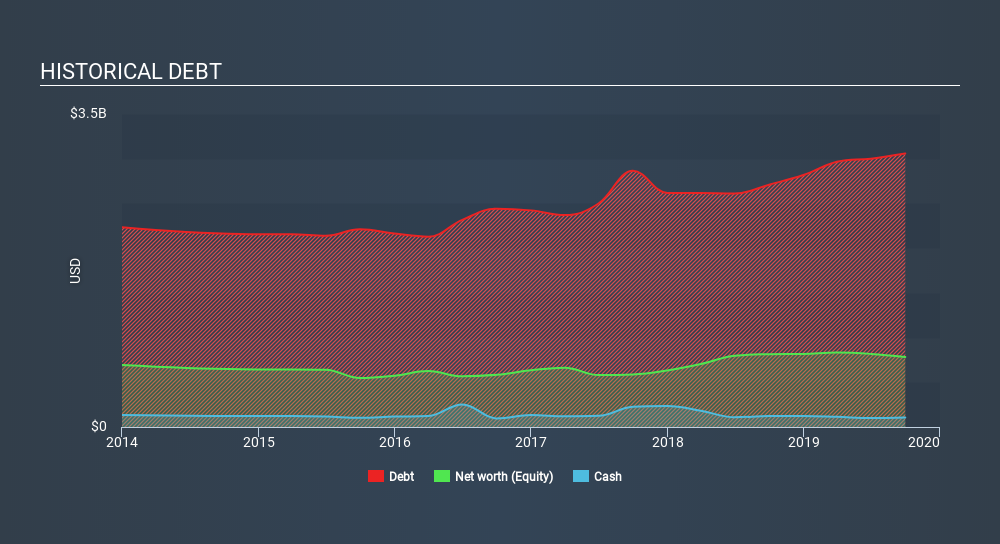
Legendary fund manager Li Lu (who Charlie Munger backed) once said, 'The biggest investment risk is not the volatility of prices, but whether you will suffer a permanent loss of capital. So it might be obvious that you need to consider debt, when you think about how risky any given stock is, because too much debt can sink a company. As with many other companies Red Rock Resorts, Inc. (NASDAQ:RRR) makes use of debt. But should shareholders be worried about its use of debt?
When Is Debt A Problem?
Debt is a tool to help businesses grow, but if a business is incapable of paying off its lenders, then it exists at their mercy. In the worst case scenario, a company can go bankrupt if it cannot pay its creditors. However, a more frequent (but still costly) occurrence is where a company must issue shares at bargain-basement prices, permanently diluting shareholders, just to shore up its balance sheet. By replacing dilution, though, debt can be an extremely good tool for businesses that need capital to invest in growth at high rates of return. When we examine debt levels, we first consider both cash and debt levels, together.
View 4 warning signs we detected for Red Rock Resorts
What Is Red Rock Resorts's Net Debt?
You can click the graphic below for the historical numbers, but it shows that as of September 2019 Red Rock Resorts had US$3.06b of debt, an increase on US$2.71b, over one year. However, it does have US$106.8m in cash offsetting this, leading to net debt of about US$2.95b.

How Healthy Is Red Rock Resorts's Balance Sheet?
We can see from the most recent balance sheet that Red Rock Resorts had liabilities of US$270.1m falling due within a year, and liabilities of US$3.07b due beyond that. Offsetting these obligations, it had cash of US$106.8m as well as receivables valued at US$53.8m due within 12 months. So it has liabilities totalling US$3.18b more than its cash and near-term receivables, combined.
Given this deficit is actually higher than the company's market capitalization of US$2.72b, we think shareholders really should watch Red Rock Resorts's debt levels, like a parent watching their child ride a bike for the first time. In the scenario where the company had to clean up its balance sheet quickly, it seems likely shareholders would suffer extensive dilution.
We use two main ratios to inform us about debt levels relative to earnings. The first is net debt divided by earnings before interest, tax, depreciation, and amortization (EBITDA), while the second is how many times its earnings before interest and tax (EBIT) covers its interest expense (or its interest cover, for short). Thus we consider debt relative to earnings both with and without depreciation and amortization expenses.
Red Rock Resorts shareholders face the double whammy of a high net debt to EBITDA ratio (6.0), and fairly weak interest coverage, since EBIT is just 1.3 times the interest expense. This means we'd consider it to have a heavy debt load. Even more troubling is the fact that Red Rock Resorts actually let its EBIT decrease by 9.9% over the last year. If it keeps going like that paying off its debt will be like running on a treadmill -- a lot of effort for not much advancement. There's no doubt that we learn most about debt from the balance sheet. But it is future earnings, more than anything, that will determine Red Rock Resorts's ability to maintain a healthy balance sheet going forward. So if you're focused on the future you can check out this free report showing analyst profit forecasts.
Finally, a business needs free cash flow to pay off debt; accounting profits just don't cut it. So we always check how much of that EBIT is translated into free cash flow. Over the last three years, Red Rock Resorts saw substantial negative free cash flow, in total. While investors are no doubt expecting a reversal of that situation in due course, it clearly does mean its use of debt is more risky.
Our View
To be frank both Red Rock Resorts's interest cover and its track record of converting EBIT to free cash flow make us rather uncomfortable with its debt levels. And even its level of total liabilities fails to inspire much confidence. Taking into account all the aforementioned factors, it looks like Red Rock Resorts has too much debt. While some investors love that sort of risky play, it's certainly not our cup of tea. Given our concerns about Red Rock Resorts's debt levels, it seems only prudent to check if insiders have been ditching the stock.
Of course, if you're the type of investor who prefers buying stocks without the burden of debt, then don't hesitate to discover our exclusive list of net cash growth stocks, today.
If you spot an error that warrants correction, please contact the editor at editorial-team@simplywallst.com. This article by Simply Wall St is general in nature. It does not constitute a recommendation to buy or sell any stock, and does not take account of your objectives, or your financial situation. Simply Wall St has no position in the stocks mentioned.
We aim to bring you long-term focused research analysis driven by fundamental data. Note that our analysis may not factor in the latest price-sensitive company announcements or qualitative material. Thank you for reading.
About NasdaqGS:RRR
Red Rock Resorts
Through its interest in Station Casinos LLC, develops and manages casino and entertainment properties in the United States.
Undervalued second-rate dividend payer.
Similar Companies
Market Insights
Community Narratives


